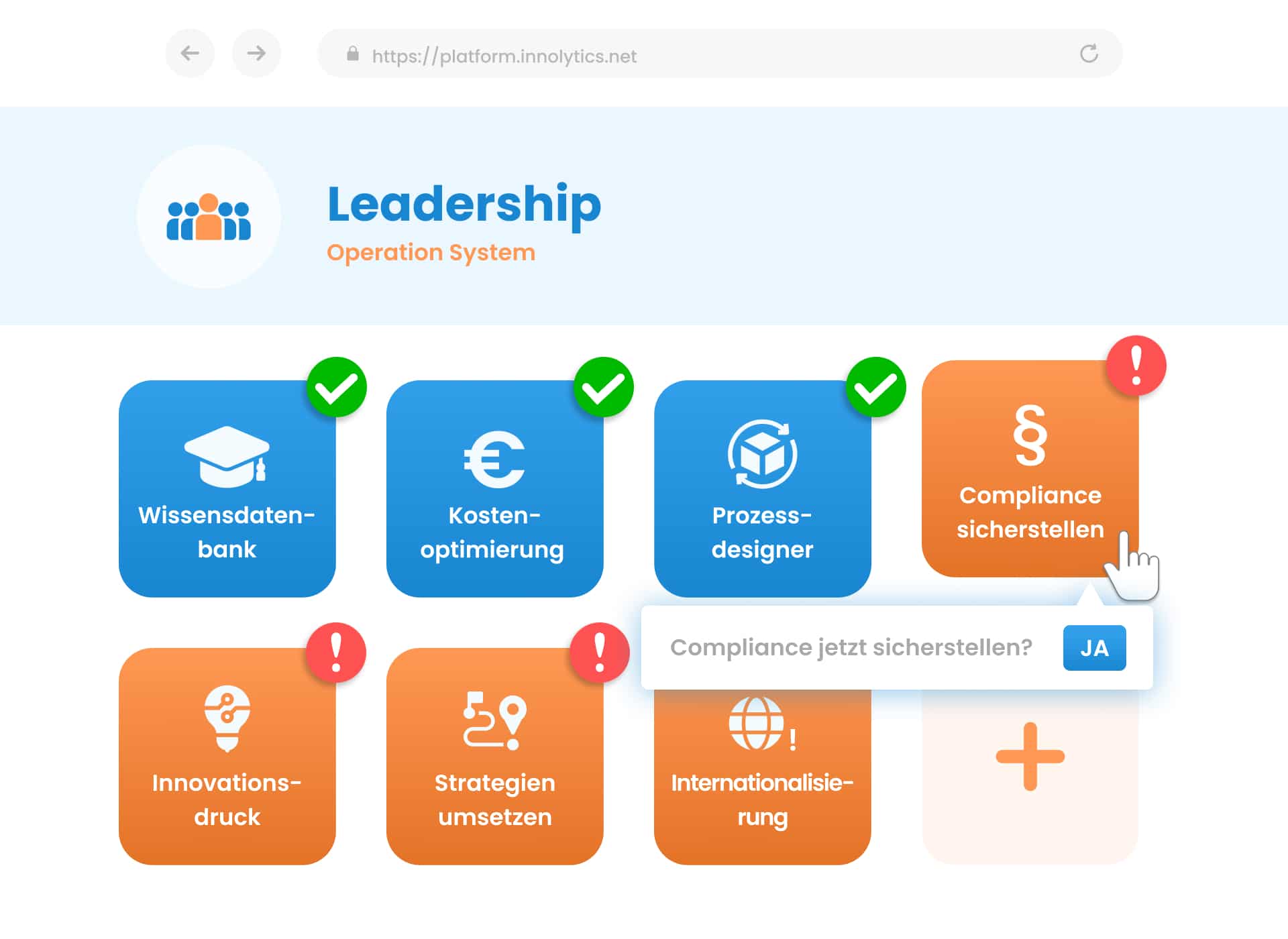WELCOME TO THE NEW LEADERSHIP OPERATING SYSTEM
Put an end to months of time-consuming software projects. Solve complex management challenges with a single click. Through an AI-powered software suite designed for leading-edge enterprise management.







All-in-one solution
FOR CORPORATE SUCCESS
Wouldn’t it be amazing if there was a solution that radically simplifies the management of internationally operating enterprises? A software that enables the seamless integration of cutting-edge applications such as conversational AI and machine translation?
This solution is here. It is called Innolytics® OS.
Ensure the quality of your processes and products
Increase your competitiveness through innovation
Share knowledge quickly and easily
Ensure compliance and sustainability
Protect your company effectively against risks
As simple as possible.
As comprehensive as necessary.
Think of Innolytics® as a shelving system: Everything fits together. Everything is simple. And it can do a lot. You can start small – just like with your first shelf in your first apartment. When new use cases are added, a few clicks are enough. Start with knowledge management. With quality management. Or our module for audits, controls and inspections. Add to and expand at any time.
Just Click Done Fits
As simple as possible.
As comprehensive as necessary.
Think of Innolytics® as a shelving system: Everything fits together. Everything is simple. And it can do a lot. You can start small – just like with your first shelf in your first apartment. When new use cases are added, a few clicks are enough. Start with knowledge management. With quality management. Or our module for audits, controls and inspections. Add to and expand at any time.
Just click Done Fits
1
We Analyzed Hundreds
of Solutions
2
Identified the Critical
Features for Success
3
And Integrated Them
into a Single Solution

Management systems: Why an integrated solution is superior
Every new solution takes up resources. Needs new responsibilities. Creates more complexity. Requires expensive training. An integrated management system is more efficient. And simpler. And more flexible.
Less complexity
Ensure the quality of your processes and products
More flexibility
Everything adapts to you
Fewer interfaces
Everything is connected with each other
Less training effort
An intuitive user interface for all employees
Lower total costs
You only pay for the modules you actually use
Less administration
Significant reduction due to automation
The modules: Simple. Effective. Integrated.
Think of Innolytics® as a shelving system: Everything fits together. Everything is simple. And it can do a lot. You can start small – just like with your first shelf in your first apartment. When new use cases are added, a few clicks are enough. Start with knowledge management. With quality management. Or our module for audits, controls and inspections. Add to and expand at any time.



How Innolytics® customers benefit from the software
Learn how Innolytics® customers reduce complexity by bundling different management systems on one platform. Reduce administration and training efforts. Save costs. And gain efficiency.
“>bbw Group: Audit and Innovation Management in Advanced Training
“>Under the umbrella of Bildungswerk der Bayerischen Wirtschaft e. V., 17 educational, integration and consulting organizations with around 10,000 employees are active – nationwide as well as internationally in 25 countries on four continents. The group of companies is committed to clear quality standards and continuous development. Regular internal audits and improvement and innovation management serve as the basis for ISO 9001 certification. The bbw group uses the Innolytics® software for both.
Rhenus Logistics: 750,000 euros in savings in the first year.
Rhenus Home Delivery is one of the leading logistics service providers in the B2B and B2C sectors and develops customized logistics concepts for its customers’ supply chain requirements. Around 550 users are registered on the platform. With ideas such as Micro Depots, B-Box and Dimensioning, the company was able to realize savings of 750,000 euros after just one year.
RWZ: Ideas, knowledge and learning management as drivers of corporate development
With more than 2,000 employees, Raiffeisen Waren-Zentrale Rhein-Main eG is one of the largest cooperatively organized companies operating in the agricultural trade in Germany. The company markets the agricultural products of its affiliated farms at almost 100 locations and supplies farmers and producers with the goods they need to produce their goods successfully. The company is driving its development centrally with the “meine idee” platform, which is based on the technology of Innolytics AG.
Innolytics® Business Academy
Discover exclusive management insights in our free business Wiki!
“>Learn more about ideation, idea generation, idea management, innovation management, process improvement and continuous improvement.
Understand the fundamentals of innovation strategies and innovation leadership. Learn how to establish innovation labs and innovation networks using state of the art innovation software.
Gain sound knowledge about innovation processes, measuring innovation, building an innovation culture and increasing the innovation capability of companies.
Learn about the differences between incremental innovation and disruptive innovation or radical innovation. Gain valuable knowledge about business innovation, service innovation and product development.
Understand how digitalization and digital disruption are changing markets. Discover how to develop digital innovation and successfully implement digital business models by using state-of-the-art innovation software.